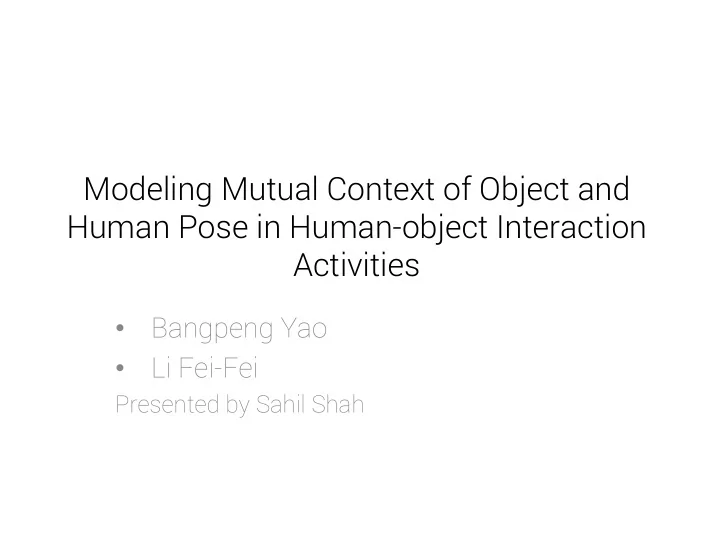

Modeling Mutual Context of Object and Human Pose in Human-object Interaction Activities • Bangpeng Yao • Li Fei-Fei Presented by Sahil Shah
Agenda • Introduction • Problem Formulation • Learning • Inference • Results
Agenda • Introduction • Problem Formulation • Learning • Inference • Results
Introduction • Note on author – Pioneer of ImageNet dataset – Must see TED talk in March 2015
Introduction • Problem: Detecting objects in cluttered scenes and estimating articulated human body parts especially in human object interaction activities
Introduction
Introduction
Introduction • Key insight: Mutual Context – Automatically discover relevant poses – Automatically discover spatial relationships – Optimize for mutual co-occurrence of object and pose
Introduction • Contribution – Builds up on Prof. Gupta’s work – First to use mutual context – Jointly solve object detection & pose estimation
Agenda • Introduction • Problem Formulation • Learning • Inference • Results
Problem Formulation • Goal: Given an image of HOI activity we need to estimate human pose(H), detect the object(O) and classify HOI activity(A) • Model – Hierarchical Random Field – A,O and H contribute to detection of each other – H is a hidden variable – Body parts {P n } are found using feature based detectors and they compose to form H
Problem Formulation Golf ¡Swing ¡ Tennis ¡Forehand ¡
Problem Formulation
Problem Formulation • Why need to learn structure? – The model captures important connections between object and the body parts – Which parts of the body should be connected to overall pose (H) and object (O)?
Problem Formulation • Model – Overall model: Ψ = ∑ 𝑥 𝑓 𝜔 𝑓 – A,O,H: 𝜔 𝑓 ( 𝐵 , 𝑃 ), 𝜔 𝑓 ( 𝐵 , 𝐼 ), and 𝜔 𝑓 ( 𝑃 , 𝐼 ) • Counting co-occurrence frequencies – Spatial Relationships: 𝜔 𝑓 ( 𝑃 , 𝑄 𝑜 ) & 𝜔𝑓 ( 𝑄 𝑛 , 𝑄 𝑜 ) • bin( l 𝑃 − l 𝑄𝑜 ) ⋅ bin( 𝜄 𝑃 − 𝜄 𝑄𝑜 ) ⋅ 𝒪 ( 𝑡 𝑃 / 𝑡 𝑄𝑜 ) – Compatibility: 𝜔 𝑓 ( 𝐼 , 𝑄 𝑜 ) • bin( l 𝑄𝑜 − l 𝑄 1 ) ⋅ bin( 𝜄 𝑄𝑜 ) ⋅ 𝒪 ( 𝑡 𝑄𝑜 ) – Object & Body parts: 𝜔 𝑓 ( 𝑃 , 𝑔 𝑃 ) and 𝜔 𝑓 ( 𝑄 𝑜 , 𝑔 𝑄𝑜 ) • Shape context feature based detectors
Agenda • Introduction • Problem Formulation • Learning • Inference • Results
Learning • Input and Output Images with labeled Set of models- each for objects, body parts & Model Learning one human pose in a HOI particular HOI activity
Learning • Overall Algorithm
Learning • Hill climbing structure learning – Each pose in each HOI activity class – Add/remove an edge and check for optima – Keep tabu list to avoid revisiting solutions – Randomly initialize thrice to avoid local optimas
Learning • Max-margin for parameter estimation – Maximize discrimination between different A – Each A has subclasses, hence multiple models and multiple weight vectors – Training sample: (x 𝑗 , 𝑑 𝑗 , 𝑧 ( 𝑑 𝑗 )) 𝑧 : maps 𝑑 𝑗 to class label – F: 𝑧 (F(x 𝑗 )) = 𝑧 ( 𝑑𝑗 ) F(x 𝑗 ) = argmax 𝑠 {w 𝑠 ⋅ x 𝑗 } w r : weights for r th sub- class.
Learning • Overall Algorithm
Agenda • Introduction • Problem Formulation • Learning • Inference • Results
Inference • Given a test image(I), estimate pose and detect object and classify activity – To detect object (O) we maximize likelihood of the models given that object. Denoted as max 𝑃 , 𝐼 Ψ ( 𝐵 𝑙 , 𝑃 , 𝐼 , I) – To detect human pose (H), compute max 𝑃 , 𝐼 Ψ ( 𝐵 𝑙 , 𝑃 , 𝐼 , I) for each A k and select the one corresponding to the ML score
Inference
Agenda • Introduction • Problem Formulation • Learning • Inference • Results
Results
Results
Results • Object Detection – Compare with two experiments 1. Sliding window as baseline 2. Pedestrian detector for human’s location context
Results
Results • Pose Estimation
Results • HOI classification – Compare with SVM with BoW – Compare with Gupta et. al.
Results • Upper-left → object detection by mutual context • Lower-left → object detection by a scanning window • Upper-right → pose estimation by mutual context • Lower-right → pose estimation by the state-of-the-art pictorial structure method
Results • Upper-left → object detection by mutual context • Lower-left → object detection by a scanning window • Upper-right → pose estimation by mutual context • Lower-right → pose estimation by the state-of-the-art pictorial structure method
Thank you!
Recommend
More recommend